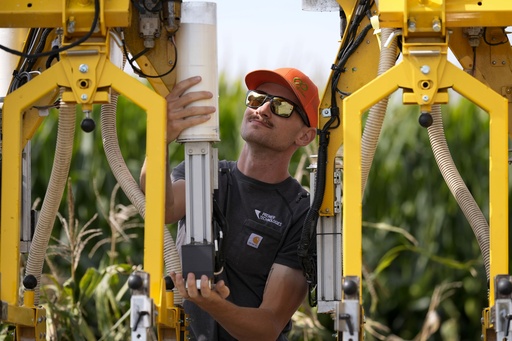HOMESTEAD, Fla. — Jeremy Ford is passionate about conserving water.
As gentle rain fell on his farm in Homestead, Florida, he expressed concerns about the costs associated with running a fossil-fuel-driven irrigation system on his five-acre property, and the environmental implications that come with it.
Recently, Ford made a significant change by installing an automated underground irrigation system powered by solar energy, allowing him to periodically irrigate the roots of his crops while conserving an impressive number of gallons of water.
Although the initial investment is higher, he views such sustainable upgrades as essential and believes they are more economical compared to hiring additional workers to support his small team of two.
“It’s much more efficient,” Ford noted. “We’ve been trying to determine how to accomplish our tasks without the need for additional labor.”
Automation in agriculture is gaining traction among various companies, aiming to address the sector’s growing labor shortages, manage operational costs, and protect workers from extreme heat.
These innovations also have the potential to enhance crop yields by providing more precise techniques for planting, harvesting, and overall farm management — all crucial as global temperatures continue to rise.
Nonetheless, numerous small farmers and producers remain skeptical.
The obstacles to adopting such technologies extend beyond the high initial costs, encompassing concerns about whether those machines can match the efficiency of human labor.
Additionally, many of those workers are apprehensive about relying on machines and the potential exploitation that could ensue from this trend.
What level of autonomy exists in agricultural automation? The answer is: not complete yet.
Some progressive farms are utilizing driverless tractors to cultivate expansive fields of crops, including corn, soybeans, and lettuce.
While this equipment investment is steep and requires the learning of new skills, automating row crops is straightforward compared to harvesting delicate fruits like blackberries or larger fruits that require strength and precise handling.
Xin Zhang, a biological and agricultural engineer from Mississippi State University, and a team at Georgia Institute of Technology, are exploring ways to employ surgical automation techniques alongside advanced vision systems to develop robotic arms for efficient berry harvesting with minimal damage.
They have conducted field trials in cooperation with farmers, but Zhang is unsure when such robots will be commercially available.
Although robotic harvesters are not commonly used yet, a few products are making their way into use across farms from Washington to Florida.
“I genuinely believe this is the future,” Zhang remarked.
However, while some view the advancements optimistically, others raise cautionary tales.
Frank James, executive director of Dakota Rural Action, a grassroots agricultural organization, has witnessed firsthand the impact of reduced labor opportunities on his family’s farm in South Dakota.
With decreasing personnel, much of the workload now falls onto James, his brother, sister-in-law, and occasionally their 80-year-old father.
He acknowledges the benefits of tractor autosteer technology, which aids in navigation through satellites.
However, it is limited in its capabilities, as it cannot assess soil moisture levels, which can hinder operations and necessitates human intervention for optimal performance.
For these reasons, James expresses doubt that automation will unequivocally dictate the future of agricultural labor.
“There’s a connection formed with the land, animals, and the environment of production, and that’s something we seem to be drifting away from,” he added.
For some farmers, adopting automation appears to be a logical solution to ongoing labor challenges.
Tim Bucher, who grew up on a farm in Northern California, has devoted his career to agriculture, grappling with issues like drought and the ramping effect of climate change.
Recognizing the pressing challenges posed by climate change and workforce shortages, he founded AgTonomy in 2021, melding his agrarian background with his expertise from Silicon Valley.
Partnering with manufacturers such as Doosan Bobcat, AgTonomy specializes in automated agricultural machinery.
Bucher noted an influx of interest from vineyard and orchard growers in California and Washington since launching his pilot programs in 2022.
Observers familiar with the industry suggest that farmers, typically wary of new technologies, may embrace automation if it enhances profitability and simplifies operations.
Will Brigham, a dairy and maple farmer from Vermont, perceives these innovations as vital to tackling the agricultural labor shortage in the U.S.
As farmers consider these changes, workers express concerns over job security and rights in an increasingly automated environment.
Tasks like detasseling corn, once a rite of passage for Midwestern youth, have shifted primarily to migrant workers facing grueling hours under extreme weather conditions.
Jason Cope, co-founder of PowerPollen, emphasizes the importance of mechanizing challenging tasks like detasseling to alleviate pressure on laborers.
His company has developed a tool that allows tractors to collect pollen without removing tassels, enabling smarter farming while reducing heavy labor.
“This innovation allows us to adjust our strategy in light of climate change,” said Cope, highlighting the efficiency introduced by this mechanization.
Erik Nicholson, who previously organized for farmworkers and now leads a nonprofit focused on agricultural laborers, reports that workers are increasingly apprehensive about the impact of automation on their livelihoods.
Many have raised safety concerns about working alongside autonomous machines but are hesitant to speak out for fear of losing their jobs.
Nicholson asserts that technology developers and farm owners should prioritize people in their decision-making processes.
Luis Jimenez, a dairy worker from New York, agrees, highlighting tools that monitor cow health.
While such technology can lead to faster detection of illnesses, it can also lead to a reduced workforce, heightening strain on existing workers.
Jimenez expressed concern about the potential for automation to be used as a tactic to intimidate workers and discourage them from demanding their rights.
“Machines don’t have demands,” he warned. “The goal is to ensure we aren’t replaced by technology.”


